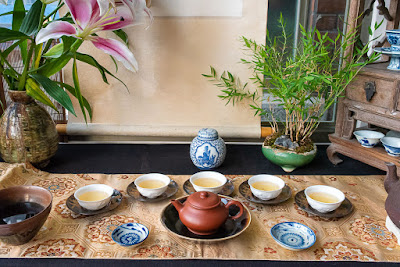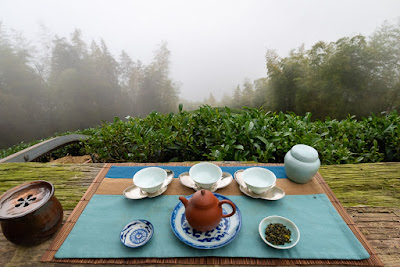"Let's fly! Let's fly away!
If you can sip,
Drink tea, it's hip!
There's a Chaxi on the way.
Come fly with me!
Let's fly! Let's fly away!"
I listened to
this Sinatra song on my way to Shan Lin Xi. Pure serendipity! With these pictures of the Shan Lin Xi mountains in the clouds, it looks as if we have an eagle eye. It's as if we were flying in the air. Blue sky and white clouds mingle with the green mountain and produce ever changing landscapes!
Let me take you to the plantation now. It's twenty to noon and the team of tea pickers is still busy on the upper side of the plantation.
With this bamboo shoot growing among the tea bushes, maybe you recognize this plantation. I've visited it
last spring and that's where I've been sourcing both my spring 2020 and winter 2020 SLX Oolongs.
This hike in the plantation is not just an opportunity to take nice pictures for promotional purposes. The goal of trips like this is to better understand the situation on the ground. This year, we want to know the impact of the dramatic drought in Central Taiwan on the high mountain plantations. So, I would also like to share the next 2 pictures to show how some parts of the plantation were impacted. Below, we can see that half the leaves turned yellow or even brown. "These bushes almost died", said the farmer. Luckily, there was some rain recently and they will survive.
Below, on the right hand side, the dark green bushes have also suffered from the drought. The impact is that they didn't produce any leaves at all. And the leaves that were produced on the light green bushes were a little bit smaller than usual last week, during the first 2 harvest days (on May 1st and 2nd). That's why there's a third harvest on May 7th (the days of these pictures).
It's noon now! After feeling very warm under the direct sunshine, clouds are now invading the plantation and are bringing a much cooler air. It's as if the A/C had suddenly been turned on! This natural moisture is also what has helped contain the damage due to the drought in high mountain plantations. And while lower yields mean more concentration in aromas in general, the quality of the Oolong tea still varies a lot from one batch to another this spring.
The workers are eating their lunch box between the tea plantation and a bamboo forest. I'm also about to eat the same lunch box as them, a kind attention of the farmer who knew I was coming.
The clouds don't lift after lunch. I feel a little bit cold and thirsty. Can you guess what I did next?
A Chaxi!
And can you guess what tea I brewed?
Qingxin Oolong from this very plantation, from spring 2020!
At that moment, I had not yet received the spring 2021 samples. But since this tea is from the same season and same plantation, the aromas felt in complete harmony!
Brewing tea outdoors is always exhilarating. Brewing tea in a tea plantation brings more challenges. Here I had to gather 3 wood planks to 'build' a table for my Chaxi. And it wasn't so easy to find a spot with such a close proximity to the bushes. I almost had to pinch myself! What a dream come true!
I'm brewing tea with style, with an
Yixing zhuni teapot,
celadon cups,
cha tuo, a
Chabu and a Jian Shui, a jar, Qing dynasty qinghua plates. This Chaxi is a celebration of this unique event and opportunity!
For me, this Chaxi is also a way to show my skills to the farmer and let him see that I'm committed to making tea in a very refined way. And it only makes sense to make such efforts with top quality leaves.
What also helps to find such leaves is to be present during the harvest time and taste the samples as soon as the harvested leaves are transformed. This year, I selected the
May 2nd batch from the Shan Lin Xi plantation. It's the most similar to the wonderful 2 spring batches of last spring.
I'm also glad to announce that it's again possible to ship Airmail and EMS to Canada. And while shipping costs to North America have increased recently, Airmail shipping is still FREE above 100 USD and EMS shipping is still FREE above 200 USD (and you receive a
free sample starting at 60 USD, plus a FREE postcard...).
Come fly with to Shan Lin Xi
Thanks a lot for your company.
'Where the air is rarefied
We'll just glide
Starry-eyed
Once I get you up there
I'll be holding you so near
You may hear
Angels cheer
Let's fly! Let's fly away!'


























































